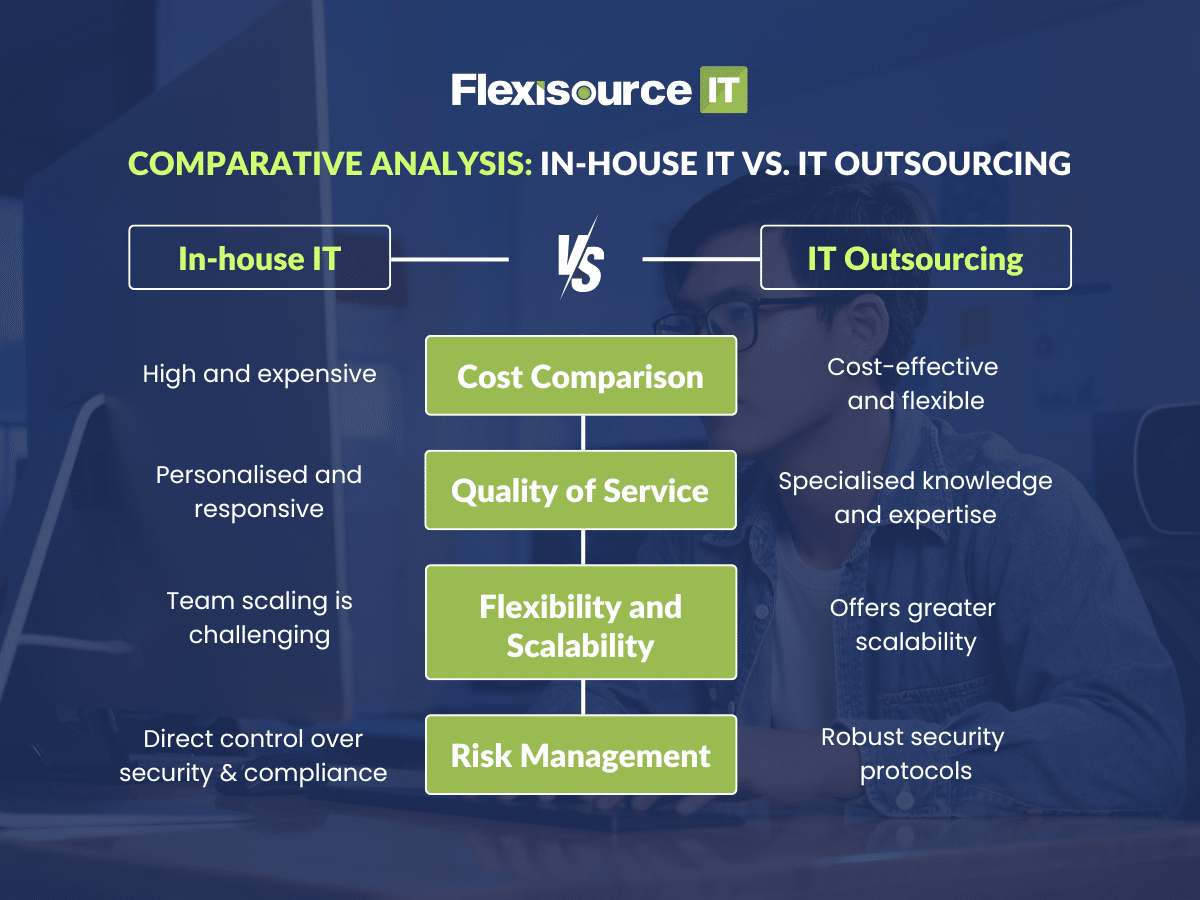Companies are faced with a critical decision: Should they maintain an in-house IT team or outsource IT services to an external provider? Both approaches have advantages and drawbacks, and the right choice can significantly impact a company’s efficiency, costs, and growth potential.
This article will explore the financial implications of in-house IT and IT outsourcing. It will provide a detailed comparative analysis to help business owners, IT managers, and decision-makers determine the most cost-effective option for their organisations.
What is In-House IT?
In-house IT refers to managing a company’s IT functions within the organisation itself. This means hiring and maintaining a team of IT professionals responsible for all aspects of the company’s technology infrastructure, from network management and cybersecurity to software development and user support.
However, maintaining an in-house IT team involves a range of direct and indirect costs that can vary depending on the company’s size, the complexity of its IT needs, and the geographic location. Here are some costs you might face when hiring an in-house IT team.
- Salaries. The most significant expense for in-house IT is employee salaries. IT staff salaries can range from entry-level technicians to highly specialised roles like network engineers, database administrators, and cybersecurity experts, depending on the expertise required.
- Benefits. In addition to salaries, companies must also provide employee benefits, including health insurance, retirement plans, paid time off, and other perks. These benefits can substantially add to the overall cost of maintaining an in-house IT team.
- Recruitment and Training. The process of recruiting skilled IT professionals is not only time-consuming but also costly. Recruitment expenses include job postings, recruitment agency fees, and the time HR personnel spend. Once hired, ongoing training is necessary to keep the team updated with the latest technologies and industry best practices.
- Infrastructure. An in-house IT team requires a physical workspace, including desks, computers, servers, and other necessary hardware. Additionally, companies must invest in software licenses, network infrastructure, and security systems to support the team’s operations.
- Ongoing Maintenance.: Maintaining an IT infrastructure involves regular updates, patch management, and hardware replacement. These ongoing maintenance tasks can lead to unexpected expenses, especially as technology evolves and equipment becomes obsolete.
What is IT Outsourcing?
On the other hand, IT outsourcing involves partnering with an external provider to manage some or all of a company’s IT functions. This can include everything from helpdesk support and network management to cybersecurity and software development. Outsourcing allows businesses to leverage the expertise of specialised IT professionals without the need to maintain an internal team.
IT outsourcing typically involves a service agreement or contract between the company and the outsourcing provider. Here are some of it:
- Fixed Price. A predetermined cost for a specific set of services or deliverables. This model is often used for well-defined projects with clear requirements.
- Time and Materials. Companies pay for the actual time and resources used by the outsourcing provider. This model is more flexible but can lead to unpredictable costs if the scope of work changes.
- Subscription-Based. A recurring fee for ongoing services, such as managed IT support or cloud hosting. This model provides predictable costs and scalability.
Like in-house IT, outsourcing your tech team incurs costs and expenses. Here is a breakdown of those IT outsourcing costs.
- Service Fees. The primary cost of outsourcing is the service fee charged by the provider. These fees can vary based on the service level, the tasks’ complexity, and the provider’s expertise.
- Contract Management. Managing an outsourcing contract requires oversight and coordination. Companies may need to allocate resources to monitor service delivery, ensure compliance with contract terms, and manage any disputes or changes.
- Integration Costs.: Integrating outsourced services with existing systems and processes can incur additional costs. This may include data migration, system integration, and training for internal staff to work with the outsourcing provider.
Comparative Analysis: In-house IT vs IT outsourcing
Cost Comparison
For many small to medium-sized businesses (SMEs), cost is critical when deciding between In-house IT vs IT outsourcing. Here is the difference between the two:

- In-House IT Costs. As mentioned earlier, maintaining an in-house IT team can be high, with expenses ranging from salaries and benefits to infrastructure and ongoing maintenance. These costs can be particularly burdensome for SMEs with limited budgets.
- IT Outsourcing Costs. Outsourcing can offer a more cost-effective solution, especially for SMEs that do not require full-time IT staff. Companies can avoid the overhead associated with maintaining an in-house team by paying for only the services they need. Additionally, outsourcing providers often have economies of scale that allow them to offer competitive pricing.
Quality of Service
- In–House Team. One of the main advantages of an in-house IT team is its deep understanding of the company’s culture, processes, and goals. This familiarity can lead to more personalised and responsive service.
- Outsourced Team. On the other hand, outsourcing provides access to specialised knowledge and expertise that may not be available in-house. Outsourcing providers are often at the forefront of technology trends and can bring a freshk perspective to IT challenges.
Flexibility and Scalability
- In-house IT. While an in-house team can be more flexible in responding to immediate needs, scaling the team to accommodate growth can be challenging. Hiring new staff, training, and investing in additional infrastructure can be time-consuming and costly.
- IT Outsourcing. Outsourcing offers greater scalability, allowing companies to quickly adjust their IT resources to match changing demands. Whether a business is expanding or facing a temporary increase in workload, outsourcing providers can scale their services up or down as needed.
Risk Management
- In-House IT. Managing IT in-house gives companies direct control over security and compliance. However, it also places the responsibility for maintaining up-to-date security measures and adhering to regulations squarely on the shoulders of the internal team.
- IT Outsourcing. Outsourcing providers typically have robust security protocols and compliance expertise. By partnering with a reputable provider, companies can reduce the risk of security breaches and ensure compliance with industry regulations. However, they must also carefully manage the relationship to ensure accountability.
Factors to Consider When Choosing Between In-House IT vs IT Outsourcing
When deciding between in-house IT vs IT outsourcing, companies should consider several factors, including:
- Business Size and Budget. Smaller companies with limited budgets may find outsourcing more cost-effective, while larger organisations with complex IT needs might benefit from an in-house team.
- IT Needs and Complexity. Companies with specialised or highly complex IT requirements may require the expertise and control of an in-house team. Conversely, businesses with standard IT needs may find outsourcing to be a more efficient option.
- Growth Projections. Companies anticipating rapid growth should consider the scalability of their IT resources. Outsourcing offers greater flexibility to scale services as needed.
- Risk Tolerance. Businesses with a low tolerance for risk may prefer the direct control offered by an in-house team. However, partnering with a trusted outsourcing provider can mitigate risks, provided the relationship is well-managed.
Conclusion
Choosing between in-house IT and IT outsourcing is a critical decision that can significantly impact a company’s operational efficiency, costs, and ability to innovate. While in-house IT offers control and familiarity, outsourcing provides access to specialised expertise, scalability, and cost savings.
Ultimately, the best choice depends on your company’s needs, budget, and growth goals. By carefully weighing the pros and cons of each option, you can make an informed decision that supports your business’s long-term success.
Contact Us at Flexisource IT to explore how outsourcing can benefit your business.





